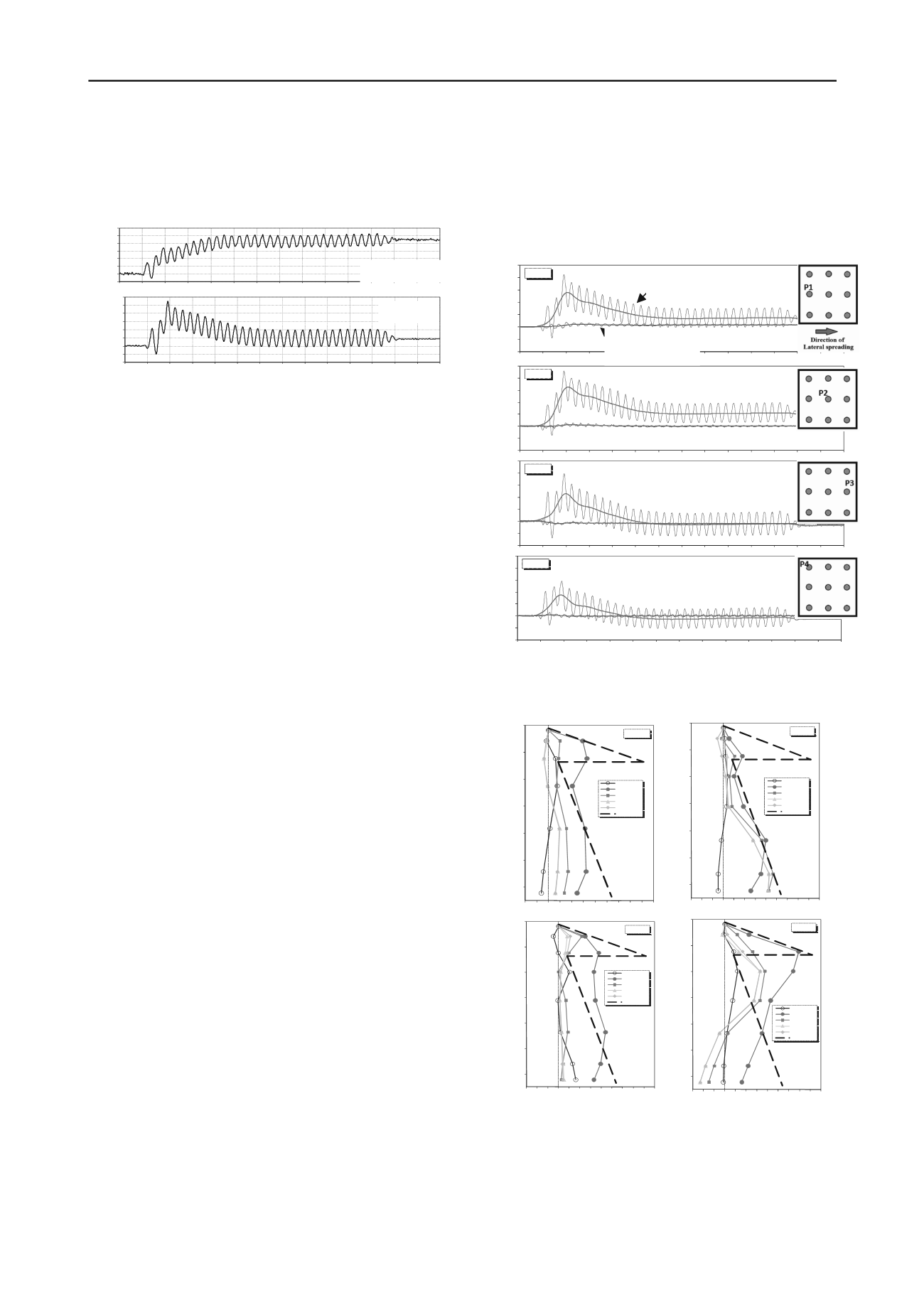
921
Technical Committee 104 /
Comité technique 104
pile cap displacement reached its maximum displacement a few
seconds after the shaking and then bounced back gradually
having a residual displacement of about 9 mm. The maximum
ground surface displacement was about 5.0 cm while the
maximum displacement of the cap was about 5.4 cm.
-1
0
1
2
3
4
5
6
0 1 2 3 4 5 6 7 8 9 10 11 12 13 14
Displacement(cm)
Groundsurface
-2
-1
0
1
2
3
4
5
6
0 1 2 3 4 5 6 7 8 9 10 11 12 13 14
Displacement(cm)
Time (sec)
Figure 4. Time histories of ground surface and lateral pile cap
displacements.
3.4. Pile bending moments
Figure 5 shows time histories of bending moments in
instrumented individual piles of the group at some
representative depths, i.e. at base of the liquefiable layer and
near the connection of piles to the cap. As seen, after lateral
spreading that occurred about t=1.5 sec, bending moments
increases significantly. However, during liquefaction, the soil
loses most of its shear resistance; hence it fails and gradually
moves around the piles. This movement reduces the lateral
pressure on the piles; therefore the piles bounce back towards
upslope due to their rigidity as the shaking continued. Due to
this elastic rebound, bending moments in piles descend as well.
It should be noted that time histories of bending moments in all
piles consist of a cyclic component due to dynamic soil
pressures as well as a monotonic component from the kinematic
lateral soil pressures during lateral spreading. An interesting
observation is that maximum positive bending moments differ
in individual piles of the group depending on their position
within the group.
4 LATERAL PRESSURE OF LIQUEFIED SOIL ON THE
PILES
The lateral pressures exerted on the individual piles of the
groups were back-calculated from the monotonic component of
bending moment data using the method introduced by
Brandenberg et al. (2010). Figure 6 shows profiles of the
monotonic component of back-calculated lateral pressures of
liquefied soil along with the lateral forces proposed by JRA
(2002) code for design of pile groups against lateral spreading.
This code recommends using 30% of the total overburden
pressure to be applied to the outermost width of the pile group
as lateral forces due to lateral spreading. In cases with a top
non-liquefiable layer, it suggests that the passive pressure from
non-liquefiable layer should be considered as well. For design
applications, implementing JRA (2002), it is assumed that the
total lateral force exerted on the pile group is equally distributed
among the individual piles of the group.
According to Figure 6, at the early stages of shaking when the
soil was not yet liquefied, induced pressures are negligible. But
upon liquefaction and lateral spreading, magnitude of lateral
pressures increased significantly. In all diagrams, an increase in
applied lateral pressures is observed at upper elevations where
the non-liquefiable crust exists. In fact, the non-liquefiable crust
moved with the underlying liquefied layer towards the
downslope during lateral spreading, exerting extra pressures on
the piles. As seen in Figure 6, the magnitude of lateral pressures
on pile 3 (the downslpe pile) in upper elevations are greater than
of the soil from the downslope side of pile 3 during lateral
spreading resulting in lack of lateral support. The agreement
between the magnitudes and patterns of back-calculated lateral
pressures with the values recommended by JRA 2002 is
reasonable except in pile 3 which shows significant difference
with JRA 2002 values in terms of pressure magnitude and
pattern.
-0.1
-0.05
0
0.05
0.1
0.15
0.2
0.25
Bendingmoment(kN.m)
Pile P1
Ground surface
those of the other piles which can be attributed to the separation
-0.1
-0.05
0
0.05
0.1
0.15
0.2
0.25
Bendingmoment(kN.m)
Pile P2
-0.1
-0.05
0
0.05
0.1
0.15
0.2
0.25
Bendingmoment(kN.m)
Pile P3
-0.1
-0.05
0
0.05
0.1
0.15
0.2
0.25
0 1 2 3 4 5 6 7 8 9 10 11 12 13 14
Bendingmoment(kN.m)
Time (Sec)
Pile P4
Figure 5. Time histories of bend
tative
ing moments in represen
individual piles of the group.
0
0.2
0.4
0.6
0.8
1
1.2
-2 -1 0 1 2 3 4 5 6 7 8 9
Depth (m)
Pile P1
t=1sec
t=2sec
t=4sec
t=8sec
t=12sec
JRA
0
0.2
0.4
0.6
0.8
1
1.2
-3 -2 -1 0 1 2 3 4 5 6 7 8 9
Depth (m)
Pile P2
t=1sec
t=2sec
t=4sec
t=8sec
t=12sec
JRA
0
0.2
0.4
0.6
0.8
1
1.2
-3 -2 -1 0 1 2 3 4 5 6 7 8 9
Depth (m)
Monotonic soilpressure (kPa)
Pile P4
t=1sec
t=2sec
t=4sec
t=8sec
t=12sec
JRA
0
0.2
0.4
0.6
0.8
1
1.2
-3 -2 -1 0 1 2 3 4 5 6 7 8 9
Depth (m)
Monotonic soilpressure (kPa)
Pile P3
t=1sec
t=2sec
t=4sec
t=8sec
t=12sec
JRA
Figure 6. Profiles of lateral soil pressures on individual piles of
3.5. Total lateral forces exerted on individual piles
ces exerted
the group during lateral spreading.
Monotonic components of maximum total lateral for
on the piles were calculated by integrating the lateral soil
pressures along the piles. These total lateral forces were
Depth=125cm
Pile cap
Depth=124cm


